- May I begin by going back quite a way to ask what your first contact with theater was?
- When I was in high school I wanted to be a painter but all of my relatives opposed that idea, saying I would never be able to make a living by painting. I rethought things and decided to become a newspaper correspondent and entered Waseda University with that intention. So I went to Waseda and on my first day there I was told by an upperclassman that I should go into theater and that I could be an actor because I was tall. I listened to him and let myself get signed up to join the Jiyu Butai (free stage) drama club. At the time, I was one of about 100 new members of the Jiyu Butai, which was a large-scale club of about 200 people in all. Within it were a number of sub groups such as a “Social Science Study Group” and other politically oriented cells that gave it a highly energized atmosphere. I was immediately swept up in that powerful energy.
- It was there in Jiyu Butai that you met the director Tadashi Suzuki with whom you would later start the Waseda Sho-gekijo (Waseda Small Theater company) and work in collaboration for some time. How did you come to write A and B and a Certain Woman , which would be your first play and the first work you would collaborate with Suzuki on?
- There was a period in 1961 when I took a leave from my theater activities and concentrated on the protest movement to stop the establishment of a military base on the island of Niijima. When I returned from that hiatus, Suzuki and his friends were wanting to do their own play apart from Jiyu Butai at the Waseda Festival, but they didn’t have a play to perform. So, I ended up writing one. That was A and B and a Certain Woman .
- It is a play in which we see man B, who feels a sense of inferiority regarding man A, continue to be derided by man A in a discourse that approaches monologue until suddenly the tables are reversed and B kills A. Although this was your debut play, it already contained so much of the characteristic “silence” and “irresolvable conflict” and even the lofty articulation of lines that we see in your later works. How did you learn to write play?
-
At the time, films were our only real source of artistic stimulation and inspiration.
A and B and a Certain Woman
was inspired by the movie
An Eye for an Eye
(directed by André Cayatte/France-Italy/1957). It is the story of an Arab man’s revenge against an European doctor, but the reason for the revenge is based on misunderstandings and the ensuing course of events that befalls bother the perpetrator and the victim of the vendetta is hopelessly twisted. I wanted to try to give expression to the process of that kind of senseless, unstoppable conflict.
Another thing was the appearance of Beckett. It was a time when people were beginning to see the limits of “realism theater,” especially the kind of social realism that we were doing. In other words, I was tired of the kind of theater that was bound by a political agenda and only had social revolution as its end game. I wanted to find some way out of that suffocating condition. It was just at that time that Beckett appeared. Personally I had been absorbed in Kafka prior to that, so for me it was a case of moving from Kafka to Beckett as my influence. It was as if I had discovered a sense of liberation in the realization that rather than the social-political agenda we had been bound to until then, theater could be based on the internal dramas of the individual like Beckett’s plays.
It was also very stimulating to see the way that Beckett would stage his works in a space that might be defined by a single tree on an otherwise bare stage. The norm in theater at the time was to have the three sides of the stage walled with panels to create a set that could be called a type of institutionalized space and then characters who were defined and restricted by that environment (system, institution) would appear. So, the kind of “naked space” where no set is created and a poor-looking “raw character” about whom we know nothing comes out on stage and the play begins from there, that kind of “Beckett space”—that is what I came to call it—was very attractive to us, and I believe that Juro Kara and Makoto Sato and the others at the time were all influenced in some way by it. - Besides this “Beckett space,” wasn’t the dramaturgy of “theater of the absurd” as exemplified by Waiting for Godot also a shocking development for you?
- It wasn’t such a big shock in terms of dramaturgy. In Europe’s Modern era, efforts to eliminate things that might be considered the absurd were one of the clear directions, so the appearance of a dramaturgy such as theater of the absurd must have been shocking. But Japan had not reached such a level of Modernization and on the individual level Western style individuality had not really been established either. Furthermore, I don’t believe that the idea of the absurd was really that new in the East. I think you could say that due to the long-standing Eastern concepts of the human being as an unfathomable entity, the acceptance of the transience of all things and the protean natural of the world, there was already a natural understanding of a sense of the absurd.
- There have been several major changes in style of your works over the course of your long career. First of all there were the earliest works that you presented in your “Waseda Small Theater” period with Tadashi Suzuki directing. Works from this period that stand not only as perceptive depictions of the Japanese and the Japanese condition but also as statements about the “souls” of the individual, were epoch-making plays in Japanese contemporary theater. For example, The Little Match Girl with its story about the peaceful life of an elderly couple gradually being invaded by a young sister and brother caught up in the hardships of the immediate postwar, or The Elephant which takes as its main character a victim of the atomic bombing who wants to show people on the street the keloid scar on his back as a way to win sympathy and applause. These works depict people who are struggling to endure hopeless solitude or isolation.
- It is true that there is an aspect of solitude or isolation, but at least for those of us with anti-establishment sentiments in the 1960s, our motivation and concern was the feelings of “animosity and agony” aroused by the conditions of the times. The moment we understood that it is a solitude resulting from animosity and agony, that solitude could become a weapon. But, as the times changed this animosity and agony faded away. Even though the social conditions or quality of life wasn’t getting any better, the increasing availability of information broadened our viewpoints and “animosity and agony” got lost in the concern for verifying solitude as solitude. By the 1980s it was almost completely gone, and with that [when expressed in terms of the Chinese characters for individual “ ko ” and isolation “ ko ” that make up the word (with the same pronunciation) solitude as in Japanese] it seemed that the individual aspect of solitude ceased to be part of the question, leaving only the isolation. I feel that the individual as a complete entity disappeared and what was left was only human consciousness as a “point.” With that, the works must naturally change too. When you try to give form to the active consciousness of isolation that exists as a “point” in this way, the only tangible form is in relationship to someone. That is why it became a theater of relationship rather than one of the actions of the individual.
- After leaving the Waseda Small Theater you wrote works based on children’s stories like Alice in Wonderland that were allegorical and rich in story narrative.
-
This was the result of the fact that the further I pursued the Beckett methodology the more autistic that work process became, to the point where I felt that the resulting theater was no longer theater and I decided to deliberately separate myself from the Beckett influence. I felt that it was not good to be involved in a creative process that of necessity drove me deeper and deeper in my own consciousness and internal questions. I have a sense of the potential of theater in a traditional definition that it should not be something introverted but something extroverted and appealing as a celebration of things external. That is why I have been able to enjoy it and why it has been liberating for me. This was theater’s appeal for me. And, I believe that is why I brought in story narrative and had the plays develop structurally around it.
Another thing is that the style of my scripts until that time was made up of monologues of self-examination. I came to dislike that. The lines reflected my own personal thoughts and emotions too much, and it came to the point where I would read over what I had written the day before and feel repulsed at it. When I could no longer write in a monologue style and changed to a dialogue style, my plays themselves changed in nature. It was no longer a matter of what the solitary main character did. It had become a “theater of relationships” or “relationship drama.” In other words the “relationship” became what you might call the main character [of the plays]. Needless to say, the nature of relationships changes with the times, so I had begun to use “contemporary relationships” rather than “contemporary people” as my focus and source of clues for pursuing contemporary-ness. - The play Nishi Muku Samurai (samurai looking to the west) that you did for the studio performance series of the Bungaku-za involved the strange scene of a family that has spread straw mats right beneath a telephone pole and moved a full set of furniture there so they can sit there to talk. From around the time of this work I feel the blossoming of a truly Betsuyaku theater that connects to all your works to this day.
- The at-home real-life feeling of the performing style of the Bungaku-za actors and the way they did plays with real-life settings seemed to fit my intentions perfectly. Since I thought the plays I was writing were rather abstract and ideological in nature, was worried that bringing a real-life hominess or grittiness to my previously mentioned “Beckett Space” would not work. But, on the contrary, I found that bringing more and heavier real-life aspects into the play actually succeeded in strengthening the sense of the world that lies in the background beyond the stage. I realized that through the real-life style of the Bungaku-za actors, the theatrical farce that I had originally intended to employ in “Godot” was transformed into something completely Japanese thanks to that style, which might be considered a kind of “genre” theater about real-life events [such as the “sewamono” plays of Kabuki and Bunraku].
- It is true with Nishi Muku Samurai and with your works from the early 1970s that you often used the “bare stage with a single telephone pole” stage setting.
-
The telephone pole is an invocation of the single tree in
Waiting for Godot
. In its original form, the European theater stage is deeper [front-rear] than it is wide, creating what you could call a cylindrical space that gives the stage and the action taking place there a more 3-dimensional aspect and greater depth perception. This creates an environment that cultivates interest in things like the universe or the void. I believe that a work like Godot can only be verified in that kind of space, but the space of the Japanese theater is a “horizontal” one, as typified by Kabuki theater. The drama unfolds on a horizontal plane and all the movement is to the right and left. To balance that horizontal axis, and “vertical axis” becomes necessary, and that is why I used the telephone pole. But for a Japanese audience with their lack of sensitivity to the vertical axis, simply erecting a pole is not enough to create a sense of the vertical. It seems that doing something like placing a street lamp on it or tying a rope part way up and hanging a string of flags of the nations is necessary in order to get some degree of consciousness of the vertical axis. So the plan then becomes to give the pole a sense of reality by doing something like having it pasted with leaflets that are half pealing off to give a sense of real-life grittiness. Then that real-life touch becomes a point that connects to the world at large and creates the feeling of a real world.
I call this kind of space “localized space.” It is neither the type of “typical place” of the kind used in realism theater, like an anonymous room that could be anyone’s room, nor is it a “symbolic place” like the edge of a cliff, nor a “codified place” of the kind that appears in abstract expressionism or a “random place” of the kind that I liken to a leg of an insect in a miniature painting—neither gathering several of them together or expanding it in size will ever make a whole insect. But, if you proceed to paint that leg with great detail, you find that at some point it begins to give you a sense of what the entire insect would be like. In the same way, the space that gives you a sense of the world at large or the universe that lies beyond that space is what I call the “localized space,” and I believe this is a very important for a place where theater tales place. And I feel that this is the way the spaces that Beckett created also functioned. - Nishi Muku Samurai , as a family drama that takes place under a telephone pole, was originally reviewed as “a play that dealt with lives of the [middle class] commoners” ( sho-shimin in Japanese from the French petit bourgeois ).
- At the time, critics wrote that it was ridiculing or negating the common people, but in fact I believe that it is the common people who supported Japan’s “economic miracle” [high economic growth rate] after World War II. The common middle class was the reality, the actual state of Japan. If I were to compare the healthy mental/spiritual state of the common people of Japan at that time with something, it would be lower ranked samurai of an earlier age with their extreme seriousness, honest to a fault, unbending in their ideals, hardworking nature. Nonetheless, the expression sho-shimin (middle class common people) eventually came to be used mocking, and that was because of the eventual collapse of a state that could be called middle class. And that collapse of the middle class came at about the same time as the collapse of the family in Japanese society. So, today the taproot of Japanese society that was previously made solid by the middle class and the family became empty and without substance, and I feel that has led to a hollowing out of the Japanese nation.
- If the “individual” giving way to “solitude” that you mentioned earlier and the hollowing out of Japan’s taproot that you have just mentioned are occurring, that is certainly an interesting state of affairs that perhaps means that even if the long-awaited Godot were to come, few would be able to find a meaningful experience in the arrival. This is the kind of contemporary condition you took as your theme in the latest work you brought out this year, titled Yattekita Godot (Godot has come) with the subtitle “ Fujori Dotabata Kigeki ” (slapstick comedy of the absurd). Do you by any chance believe that Beckett’s Waiting for Godot is a play that should be read with a sense of humor?
-
Yes, I believe so. When seen as a whole, I think that the theater world is still infected with the belief that tragedy is the true path of theater. But, I believe that comedy is actually the most effective way to depict the contemporary world. I think that is in fact comedy that is the true path and, although it may seem like an extreme way to express it, tragedy is an outdated way of measuring human existence in terms of the old context of “a dialogue between human beings and the gods” [or between the Christian or Muslim and his/her God]. In reality, comedy is clearly the mainstream in our daily lives today and I feel that we are in an age when the patterns of action of comedy are highly effective. So, if you think
Waiting for Godot
is an important work, I think you should try to read it with a sense of humor, and
Yattekita Godot
(Godot has come) is a play I wrote in an effort to make “Godot” succeed as a comedy.
I think you will agree that there is a tendency in the world at large today to look down on comedy as something corny and meaningless. The only time it is really appreciated is when it includes social satire. But the comedy I am interested in is not that kind. It is pure “nonsense comedy” that has no social satire or anything like it. Nonsense comedy is the purest form of comedy, and I would even go on to say that I feel nonsense comedy is the ultimate form of absurdist theater. I believe that Ionesco’s The Lesson and The Chairs are ultimate nonsense comedy. - Your plays have a quality that doesn’t end with laughter of the moment but leaves a lasting and inspiring impression on the audience of the work as a whole after the performance is over. It seems to me that when you are writing these plays you must have something in your mind that transcends the theatrical space of the play itself and it is the tension between these two dimensions that brings the work to the realm of the universal.
- Yes, there is a sense of something transcendental. It is something different from the Western concept of God, something connected to the Buddhist concept of “ ku ” (emptiness), something that might be expressed with words like void or nihility. Kafka said that before the gods, man is always in the wrong. Even when it is the gods that are wrong, it is always man that is judged to be wrong. If it is truly the human being that is always in the wrong, this is tragedy. But if the human being is judged to be in the wrong even when it is the gods that have been wrong, this is comedy—I believe that this is the ultimate form of absurdist comedy. I believe that we want some transcendent entity not as an object of worship but as a means to confirm whether human beings are indeed in the wrong or not.
- In 2003, you took the position as director of Hyogo Prefecture’s Piccolo Theater company (Amagasaki Youth Creative Theater of Hyogo Prefecture). How has that been for you?
-
I don’t think the kind of grand-scale dramas we were doing in the 1960s that took on the world as a whole and said “This is the contemporary world” can be valid theater in today’s world. If there is one redeeming hope, I believe it is that there can be region specific theater based on the character of a particular region or locality. In that sense, I believe it is a quite important development that local theater companies are beginning to do plays in their local dialect.
The various regional dialects of Japan are homogenized in the “unified” national dialect spoken on the national televisions station NHK, but this “standardized” language has little potential or power left as a theatrical language. I feel that it has lost its “power as word” and only the meaning is left, as if it were a code. But local dialects still have physical element, a sensual element. It has not just meaning but also a smell, a resonance. And those elements give it substance and the power to arouse drama. In the past, local dialects were dismissed as something lacking in universality, but now that very lack of universality makes it effective as a tool, an added means for nurturing more intimate communication within a local community. I feel great possibility in the prospect of depending on a local community and making the effort to develop theater there that has a unique local character, using the local dialect. I feel that this kind of effort can develop into a source of broader cultural activities. - Speaking in terms of language, we have for example playwrights like Oriza Hirata , who has created what is called “Contemporary Colloquial Theater” by making almost excessive use of everyday language in his scripts. On the other hand we also have Daisuke Miura , who presents young people in their raw, pre-verbal state in his plays. And then there are young playwrights like Toshiki Okada who use the slang of today’s young people just as it is in their plays.
- I believe there is something correct and positive in such efforts. I don’t have many opportunities to see the plays of today’s younger playwrights but I can sense that they are doing simulating work in their own unique styles. That is why I am not at all pessimistic about the future of theater. I have the feeling that there will probably be new things coming out of the regional localities and that there will be new things produced in Tokyo that originate from sources other than standardized Japanese.
- This is probably a naïve question, but I would like to ask you if you believe there is an experience that the medium of theater can bring to people which cannot be experienced through other media like movies or television or music.
-
Yes, there is. I think that theater is probably the only mechanism by which life-sized people can confront life-sized people with drama in practical and effective context. I feel that, in the end, the old, inconvenient nature of theater as a moment shared by only a small number of people in a closed-off environment is actually a fortunate limitation. In this age of globalism where something spoken in Japanese is immediately translated into English and things that can be understood anywhere proliferate in borderless media, I think you can even go so far as to say that culture itself becomes a product for consumption. In an age where culture is accumulated and recorded as material for reproduction and replaying, I have the feeling that the closed environment of theater can in fact be an important foothold and source of inspiration for the creative process.
I speak in terms of nikusei (the live voice) and I say that I believe the live voice is disappearing from the world at large. The live voice retains that portion of communication that is lost when a voice is codified [in the process of being recorded or transcribed]. It is like the difference between Western medicines and Chinese herbal medicines. Instead of extracting only the necessary active ingredient, the unnecessary parts are also used in their raw, un-extracted form. Although we may not know how those unnecessary parts function, we find that the herbal medicine may have less side-effects or be easier on the body and the person. In other words there may be something important in the traditional form that has been verified by tradition. I definitely believe that theater is a tradition what contains such inexplicable elements, and it is those elements that haven’t been extracted out or abstracted that are important.
Minoru Betsuyaku
The unending quest of Minoru Betsuyaku, the playwright who has laid the foundation of Japanese drama of the absurd
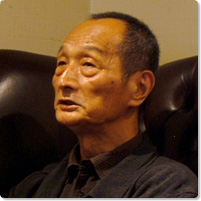
Minoru Betsuyaku
Born in former Manchuria (northeastern China), Betsuyaku dropped out of Waseda University’s School of Political Science and Economics. He was influenced by Beckett’s Theater of the Absurd and founded the Waseda Shogekijo company together with Suzuki Tadashi. His plays Zo (The Elephant, 1962) and Macchi uri no shojo (The Little Match Girl, 1966) were highly acclaimed and he won the 13th Kishida Drama Award for Akai tori no iru fukei (A Scene With a Red Bird, 1967). In 1971 he won the Kinokuniya Theater Award for Machi to hikosen (A Town and an Airship) and Fushigi no kuni no Arisu (Alice in Wonderland). The following year he won the “New Artist” award of the Ministry of Education’s Selected Artists Encouragement Awards for Soyosoyo-zoku no Hanran (revolt of a gentle family), and in 1987 he won the Yomiuri Literature Award for his collection of plays titled Shokoku wo Henreki Suru Futari no Kishi no Monogatari (tale of the foreign travels of two knights). In 1988, his play Giovanni no Chichi e no Tabi (Giovanni’s journey to his father) won the Minister of Education Award for the Arts. As of 2013, he has completed 138 works, including plays, children’s stories, and humorous essays. His nonsense “—zukushi” series, including titles such as Mushi-zukushi (A World Full of Bugs), which turns conventional biology on its head, Mononoke-zukushi (A World Full of Ghosts) about the true nature of ghosts in ancient and modern Japan, and others on animals, birds, and fish, was a big hit. Other works such as his criminology essay Hanzai shokogun (Criminal Syndrome), an astute analysis of the darker mechanisms at work behind sensational crimes, reveal the full breadth of Betsuyaku’s creative and intellectual interests.
Interviewer: Hirofumi Okano
A to B to Hitori no Onna (A and B and a Certain Woman)
Premiere: 1961
This is a work that depicts a fight resulting from unfounded animosity and feelings of inferiority between two men A and B who deride each other and refute with an exchange of long monologues. A tells B that he is balding and has a bad leg. B says that he hates himself because he is stupid and a freeloader and grovels that A should tell him to his face to quit living such a depraved life. He finally implores A to kill him. As the dialogue proceeds, however, there is a turn in direction and it turns out that it may be A who actually has a bad leg. Finally with rancorous relationship swings a full 180 degrees and B ends up killing A.
Match Uri no Shojo (The Little Match Girl)
Premiere: 1966
One night a woman pays a visit to the home of an ordinary middle-class elderly couple. She says that she used to sell matches on the street corner as a child and lift the hem of her skirt to show herself [to customers] for the length of one match’s light. Then she accuses the elderly man of being the one who taught her to do that. Of course, the man objects that he doesn’t know what she is talking about. The woman brings her younger brother to the home and even invites some children in and gradually impinge more and more on the couple’s life. It is a work that harshly criticizes the “postwar commonsense” attitude of pretending that the tragic cruelties and shady events of the past had just never happened.
Zo (The Elephant)
Premiere: 1962
This is the story of a patient who is a victim of the atomic bombing and has a strange desire to show people on the street the keloid scar on his back and use it as a way to win sympathy and applause. His nephew tries to stop him from such actions and convince him that people neither love nor hate or are repulsed by the atomic bombing victims. People are just unquestioningly kind and understanding, so we victims of the atomic bomb should be strong and suffer our pain in silence, he tells his uncle. From the contrasting feelings of these two characters we sense the estranged world these victims have fallen into and, by extension the existential anxiety that the entire world must bear. It is a work that deals with these questions in style strung taught with silence.
I Am Alice
Premiere: 1970
In a country where a republican government and a monarchy exist simultaneously in a confused national state, Alice is accused one day by both the republic and the monarchy of conspiring to rebellion and given double sentences of exile. In exile, Alice re-discovers her identity as Alice again and sends to the world a telegram pronouncing, ”I am Alice. ” In a children’s story style, this work tells us that in a regimented society, [the artist] must throw out his/her name once and find their true self once again before true identity can be gained.

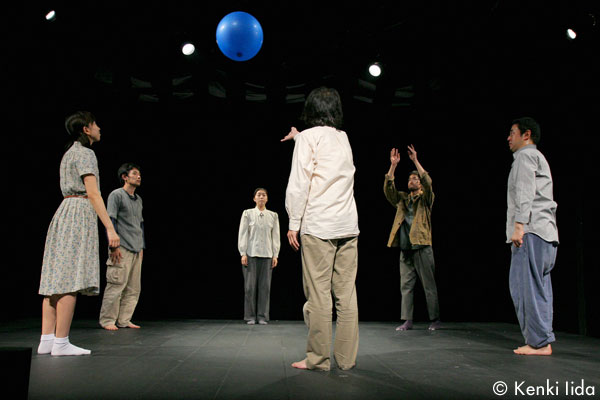
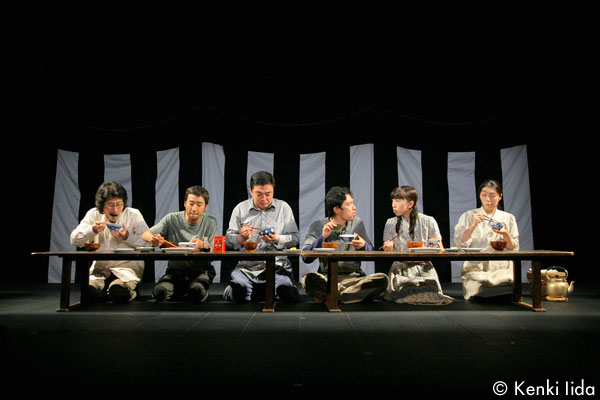
Suji de Kakareta Monogatari – “Shinou Dan” Tenmatsuki (a story told in numbers – the end of the “let’s die group”)
Premiere: 1974
Seven men and women have gathered under large framed words in calligraphy that read “Rite of Death by Starvation. ” They have isolated themselves this retreat with the intention of dying, but they must spend the time it takes to starve as a group of seven. What started out as something small gradually escalates, what may have started in jest grows into a life and death proposition. They count endlessly, “one, two, three, four, five, six, seven, eight, nine, ten … ” on the way to an uncertain goal.
The studio performance series of the Bungaku-za
Suji de Kakareta Monogatari – “Shinou Dan” Tenmatsuki
(June, 15 – July, 5 at Bungaku-za atelier)
Directed by Hisao Takase
Photo: Kenki Iida
Nishi Muku Samurai (samurai facing the west)
Premiere: 1977
This is a story of two couples and a homeless pauper. One day the two husbands just stop going to work. They make up stories, like saying that they are going to become inventors, but in fact they spend their time doing mostly nothing. Their wives are now anxious for a clear decision by their husbands about they intend to do, but all they get is double-talk. Saying that there is nothing else they can do, the wives start up the lethal “Pauper Hunting Machine” that their husbands have invented.
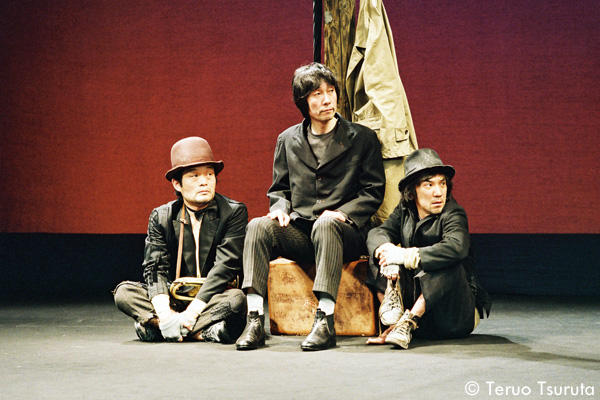
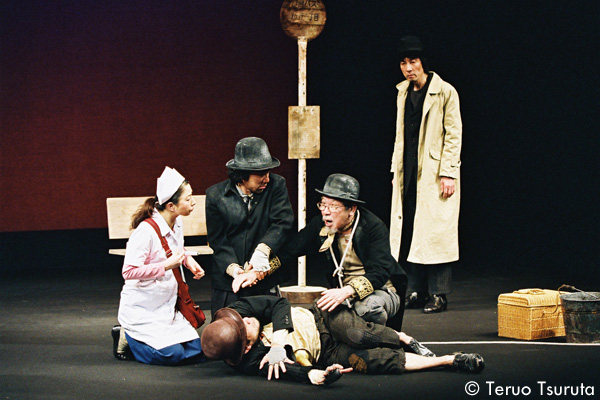
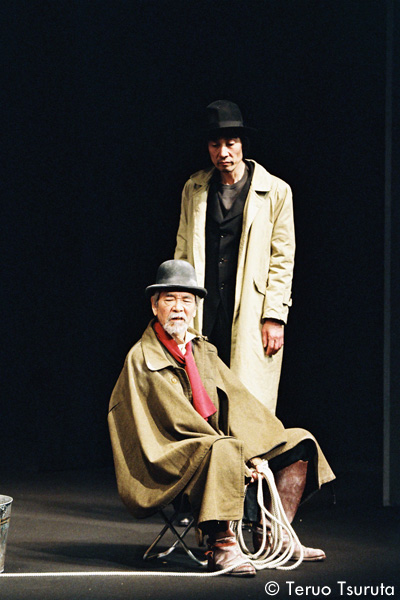
Yattekita Godot (Godot has come)
Premiere: 2007
This play borrows the dramatic setting of Beckett’s Waiting for Godot to create a new latter-day version. The Godot that Vladimir and Estragon have been waiting for so long finally appears one day. The two are aware of the fact that Godot has come, but they are unable to “experience” or grasp the reality of what the arrival means.。
Kiyama Theater Productions
Yattekita Godot
(March, 24 – 31 at Haiyuza theater)
Directed by Toshifumi Sueki
Photo: Teruo Tsuruta

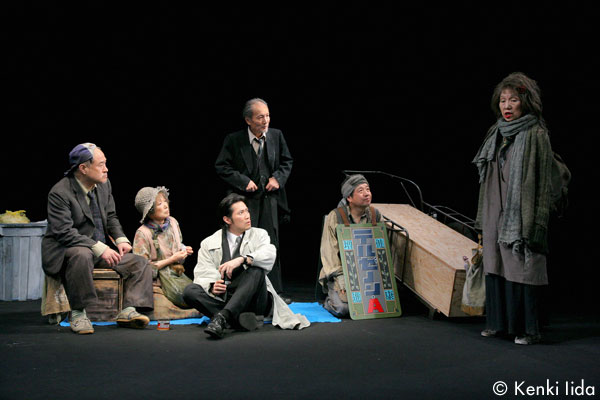
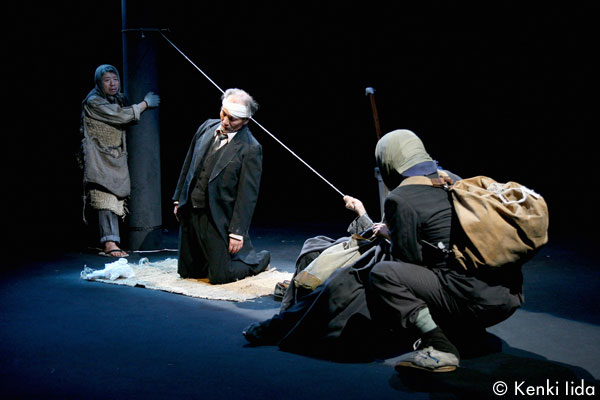
Inu ga Nishi Mukya O wa Higashi – “Nishi Muku Samurai” Gojitsu tan (if a dog faces west, the tail is to the east – postscript to “Samurai Facing the West”)
Premiere: 2007
Telephone poles stretch off into the distance. Five elderly men and women walk along in a cozy group. They don’t know the reason why, but they know that they have to keep walking in the direction they are headed. Each on them has a disease or a disability so their road is not an easy one. Also, it seems that all five share a common past but their memories are tangled and that fact confuses their relationship. This is a work that can be considered a sequel to Nishi Muku Samurai
The studio performance series of the Bungaku-za
Inu ga Nishi Mukya O wa Higashi – “Nishi Muku Samurai” Gojitsu tan
(June, 15 – July, 5 at Bungaku-za atelier)
Directed by Shinpei Fujiwara
Photo: Kenki Iida
Related Tags

